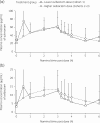Pharmacokinetics and safety of aztreonam/avibactam for the treatment of complicated intra-abdominal infections in hospitalized adults: results from the REJUVENATE study
- PMID: 31828337
- PMCID: PMC7021089
- DOI: 10.1093/jac/dkz497
Pharmacokinetics and safety of aztreonam/avibactam for the treatment of complicated intra-abdominal infections in hospitalized adults: results from the REJUVENATE study
Abstract
Objectives: To investigate pharmacokinetics (PK) and safety (primary objectives) and efficacy (secondary objective) of the investigational monobactam/β-lactamase inhibitor combination aztreonam/avibactam in patients with complicated intra-abdominal infection (cIAI).
Methods: This Phase 2a open-label, multicentre study (NCT02655419; EudraCT 2015-002726-39) enrolled adults with cIAI into sequential cohorts for 5-14 days treatment. Cohort 1 patients received an aztreonam/avibactam loading dose of 500/137 mg (30 min infusion), followed by maintenance doses of 1500/410 mg (3 h infusions) q6h; Cohort 2 received 500/167 mg (30 min infusion), followed by 1500/500 mg (3 h infusions) q6h. Cohort 3 was an extension of exposure at the higher dose regimen. Doses were adjusted for creatinine clearance of 31-50 mL/min (Cohorts 2 + 3). All patients received IV metronidazole 500 mg q8h. PK, safety and efficacy were assessed.
Results: Thirty-four patients (Cohort 1, n = 16; Cohorts 2 + 3, n = 18) comprised the modified ITT (MITT) population. Mean exposures of aztreonam and avibactam in Cohorts 2 + 3 were consistent with those predicted to achieve joint PK/pharmacodynamic target attainment in >90% patients. Adverse events (AEs) were similar between cohorts. The most common AEs were hepatic enzyme increases [n = 9 (26.5%)] and diarrhoea [n = 5 (14.7%)]. Clinical cure rates at the test-of-cure visit overall were 20/34 (58.8%) (MITT) and 14/23 (60.9%) (microbiological-MITT population).
Conclusions: Observed AEs were consistent with the known safety profile of aztreonam monotherapy, with no new safety concerns identified. These data support selection of the aztreonam/avibactam 500/167 mg (30 min infusion) loading dose and 1500/500 mg (3 h infusions) maintenance dose q6h regimen, in patients with creatinine clearance >50 mL/min, for the Phase 3 development programme.
© The Author(s) 2019. Published by Oxford University Press on behalf of the British Society for Antimicrobial Chemotherapy.
Figures
References
-
- Theuretzbacher U. Global antimicrobial resistance in Gram-negative pathogens and clinical need. Curr Opin Microbiol 2017; 39: 106–12. - PubMed
-
- Tangden T, Giske CG.. Global dissemination of extensively drug-resistant carbapenemase-producing Enterobacteriaceae: clinical perspectives on detection, treatment and infection control. J Intern Med 2015; 277: 501–12. - PubMed
-
- Walsh TR, Weeks J, Livermore DM. et al. Dissemination of NDM-1 positive bacteria in the New Delhi environment and its implications for human health: an environmental point prevalence study. Lancet Infect Dis 2011; 11: 355–62. - PubMed



